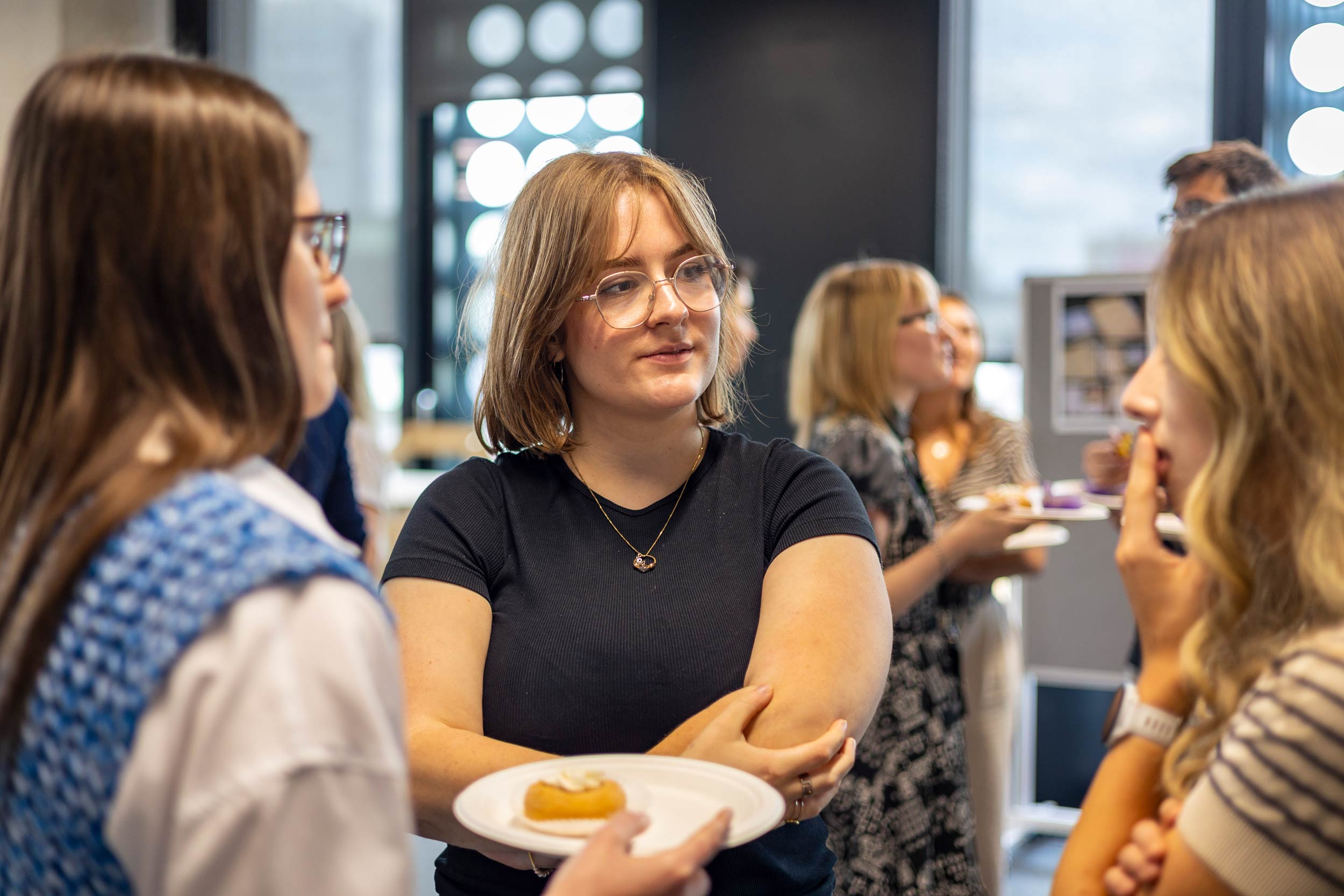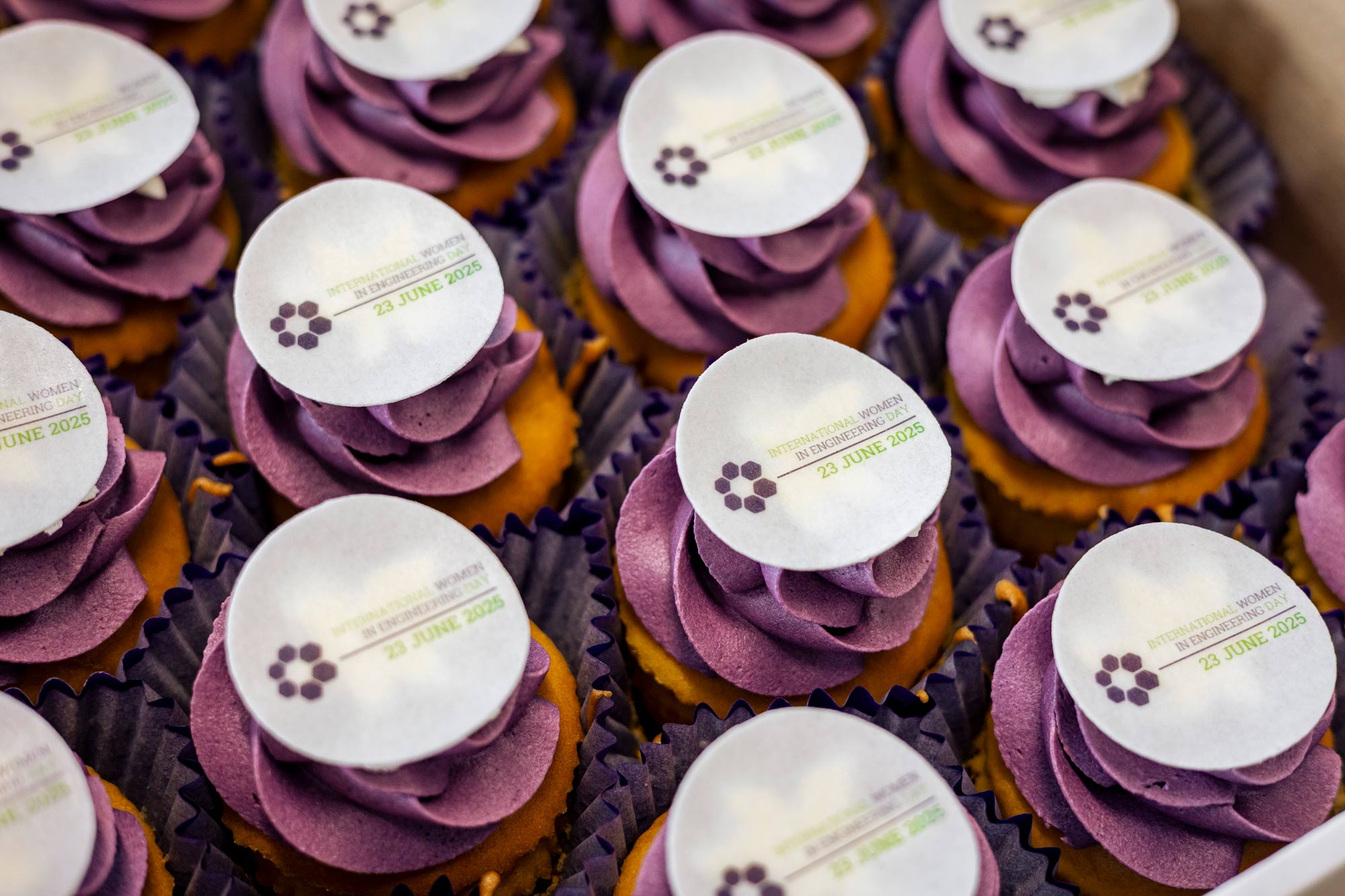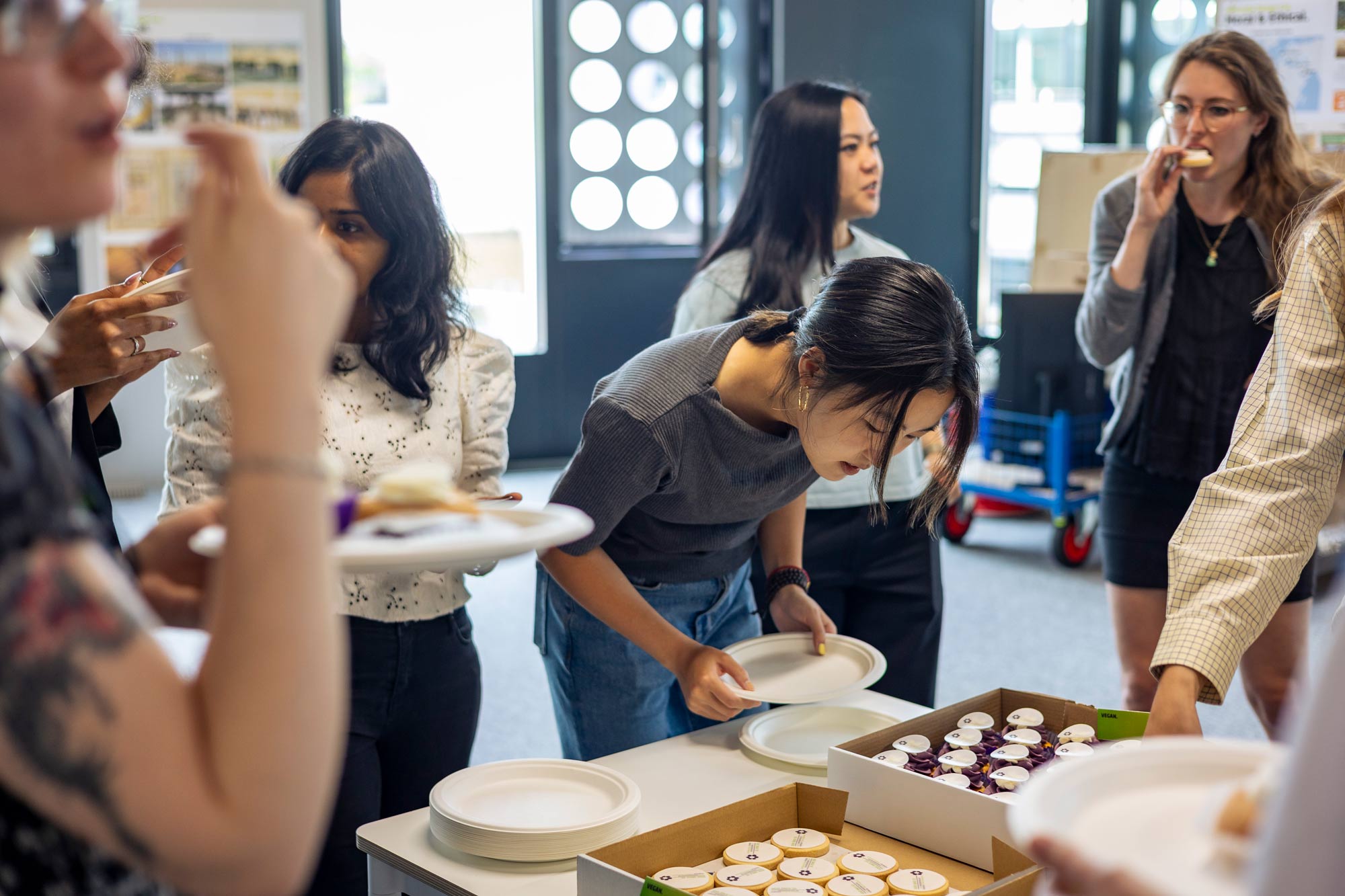To mark International Women in Engineering Day 2025, two of our engineers – Erin and Susie – sat down for an honest conversation about what it’s like to be a woman in the profession today. It’s a personal, open and hopeful take on what’s changing in our industry—and what still needs to.
Erin, Structural Design Engineer at AKT II:
What first inspired you to become a structural engineer?
Susie, Senior Structural Engineer at AKT II:
Like most of us in structural engineering, I love maths. I love physics. But I also really wanted to do something that had a creative side to it, but allowed me to develop technical skills as well. I really enjoyed learning about architecture during art history at school, especially after watching the BBC documentary Supersized Earth, which explored some of the world’s largest buildings. It sparked my interest in engineering. It made me want to do something in that realm, so I realised structural engineering is where all those elements that I liked come together. I also love being able to have an influence in the environments that we live in, the buildings that we work in, and the city that we live in. What about you, Erin?
Erin:
I was always into maths and physics at school too, but I was leaning more towards architecture. When I discovered structural engineering, it felt like something I could do that was still connected to architecture, but I would get to use my maths and physics.
Susie:
Do you think the gender bias within the industry ever came into that decision-making?
Erin:
I think when I was deciding to be an engineer, the course I did at uni was combined engineering and architecture. So, it was very gender balanced. The majority of my lecturers were male, but I didn’t let it bother me. However, I will say I was probably one of the only girls at school that really liked physics.
Susie:
That’s an interesting one. How do you encourage more young girls to go into engineering? I felt, going from an all-girls school, that was never an issue because there was never that bias at school. If you wanted to do physics, you did physics. And if you wanted to do maths, you just did maths. What’s your experience with that?
Erin:
Thinking back on school, when it came down to us picking sciences, all the girls did biology and all the boys did physics. And that’s just kind of how it was. I ended up doing both. There was only one boy in my biology class and two girls in my physics class. I feel like the gender divide in the industry starts from then. If you don’t do physics in school, then you’re not going to become an engineer. So, if girls aren’t picking physics, there won’t be female engineers. What kind of actions do you think could be taken to help this kind of gender bias from a younger age?

Erin chatting at the INWED breakfast catch up hosted at our London HQ.
Susie:
I think it’s exposure. I think a lot comes from just showing young people what opportunities are out there. When it comes to schools, often you have your curriculum and that’s quite fixed, so to provide opportunities for people to expand beyond what they know is always going to be helpful. I think one of the great things we do at AKT II to help combat this is AKT.Educate – going into schools, especially in areas where they might not have those experiences of engineering offices, and exposing the kids to what we do, providing them with opportunities to make those decisions, and encouraging them to seek alternative paths. We all live in our own bubbles, and we need to find ways to not burst the bubble, but lead the bubble in other directions. And that’s not just in engineering, but in all fields and disciplines, and making sure that it’s also opportunities for girls and boys and everyone else.
[AKT.Educate is AKT II’s programme that aims to promote STEM and engineering in underrepresented demographies.]
Erin:
Get girls more into physics!
Susie:
Yeah! I remember we had a science workshop in school where we built bridges out of spaghetti to transport an egg from one side of the room to the other. And I thought that was so fun. At the time, I probably didn’t think that was going to be an influential day in my life, but that definitely planted a seed for me and sparked my interest in science – even if I didn’t realise at the time because it was disguised as a fun game. But it exposed me to a whole new world. I also think there’s a lack of general understanding of what an engineer does, so the more people that understand what it is, the more people we can get interested in engineering.
Erin:
That’s kind of how I just fell into engineering. I didn’t really know that it was an option. I was just like, I like buildings. I like architecture. So, when I was exploring my uni course options, I realised – cool, engineers can do things that really interest me! I remember literally googling what’s the difference between an architect and a structural engineer? I just didn’t get it at first. Sometimes you just don’t know the opportunities are out there and what you can do, because it’s not shown to you. When I was younger, growing up in Scotland, I just envisioned an engineer as someone who worked on an oil rig! I had no idea it entailed so much creativity and working with people.
Susie:
I agree, the profession could definitely do with better exposure.
Erin:
Yeah! So, what I’ve noticed since starting to work as an engineer is that when we go on site, most of the contractors are men. How did you go about building up your confidence working in this environment? Do you have any advice for someone that’s just starting out?
Susie:
I think one of the biggest transitions we make in our careers is leaving uni and realising that there’s the big working world around us, and trying to build up that confidence. When it comes to working on site and working with any new people, it’s important to stay true to yourself. You shouldn’t adapt your ways just to meet someone else’s needs. It should be a collaboration between them and you. It’s getting to know people, understanding your team, understanding them as people to allow them to understand you. That could be through having a team meeting just to introduce yourselves to each other, or maybe go to project drinks. I think developing those relationships with the people you work with is one of the best ways to enhance the collaboration and also get that confidence that you need in order to progress – and for the team to have confidence in the project as a whole. Sometimes it might be that you have to have a difficult conversation on site, but the more you navigate difficult situations, the easier it becomes. It does feel, as women, we have to push harder. You have to put more of an effort in, and I think in those instances, it’s good to communicate that effort with your team and make sure they understand what you are trying to do. And whilst you might be the person going forward to present something, you have a team behind you and you’re never alone – even when it feels that way. We need our allies as much as we need ourselves to push forward.

Erin:
How have you approached leadership as a senior engineer, now having people that are more junior than you? And how have your experiences earlier in your career shaped your leadership style?
Susie:
As a senior engineer, one of my roles is to help mentor junior engineers – both in their technical skills but also in their professional skills. I am constantly reminding myself what it was like to be a design engineer as well, and not to forget that it is hard and they are learning lots and experiencing a lot of new things all at once. I try to get to know the people I’m mentoring to understand the way they like to work, the way they process things. You want them to help you as much as you are helping them too. I try to mentor with a growth mindset, so that they are developing as people as well as getting benefits for the project and ensuring its progress. I think what’s great about AKT II is that there are a lot of opportunities to learn something new. The Next Generation Network is really good because it gives you an opportunity to see the bigger picture throughout the wider company that you might not get a chance to otherwise. I think overall, it’s looking at ways in which we can collaborate as people, looking at the communication skills, looking at ourselves as people as well as professionals, and how we can work together as a team. It’s being open-minded and adapting those ways to meet the needs of the company and the projects.
What about you, Erin? How do you like to be led? What kind of things do you find beneficial from a leader?
[The Next Generation Network is a forum for young staff within AKT II and fellow Tyréns Group company Hilson Moran that fosters collaboration, knowledge exchange and professional development.]
Erin:
Everyone here is always learning, but I feel like at this stage in my career, I have a lot more to learn, so I really like being around people who encourage me to be inquisitive. I like to feel comfortable asking questions – and not that I have to secretly google something that’s been said when no one’s looking and end up not really understanding it. I also appreciate having the structure of regular check-ins and knowing who to go to with any questions or problems in between them.
Since you started working as an engineer – or even studying – have you seen the role of women in engineering evolve in any way? Or was there anything that you thought kind of helped along?
Susie:
To be honest, in my experiences that I’ve had, I’ve seen a lot of growth with myself in terms of how I’m managing things and learning – both technically and in professional development of understanding the workplace. I’ve got a long way to go still, but I’m very fortunate to have great mentors and people who support me and who will back me up. Again, I try and communicate with my team as much as possible, so that we can work together collaboratively for our development and for the benefit of the projects. Fortunately, being a woman hasn’t been a detriment in my career to date – I feel very lucky. I give credit to the environment that I’m in and the people who have supported me for that. I think the things that have helped me along are the teamwork and supportive people. What about you?
Erin:
I think in our field, around our age group, we’re a lot more equally balanced in terms of gender. But you can still see, higher up, that there are a lot more men in the leadership positions than there are women. That’s just a factor of, say, 20 or 30 years ago when these people were picking their degrees – there wasn’t as much of an initiative to get women into engineering as there is now. I see that changing in the future, as more of our generation starts to work their way up.
Susie:
Yeah, it would be good to see more women leaders up there. I think it’s super cool that [AKT II’s parent company] Tyréns have great women representation on the board. Even just seeing that is inspiring and cool.


Erin:
Also, the senior leadership team are who shape policies. So if you want more policies that will help support women, then you want more women up there. That goes for all types of diversity as well.
Do you have any career goals you’d like to reach in the coming years?
Susie:
I’d love to be chartered. Apart from that, I’d like to work on projects that are more sustainability-focused – looking at ways in which the built environment could adapt to meet global challenges, especially to align with the United Nations Sustainable Development Goals. I think there will be some very interesting design challenges ahead of us.
What are your goals, Erin?
Erin:
Obviously to get chartered. That’s the most ambitious goal. But yeah, I just like working on projects that are kind of cool. I guess I’m a bit earlier in my career, so I’m still really interested in things like new-to-existing connections. I’m working on a lot of adaptive reuse projects at the minute and finding that interesting – so probably a bit more of that. We’re in such a place with sustainability at the minute, and how we can make that better through our work. I’d like to work on more cultural buildings as well, and buildings that are for community or public use. Like a museum!
Susie:
They’re some of the coolest buildings! Museums can have such architectural freedom. You’re right, that would be cool. I’m going to steal your goal, Erin! You’ve inspired me.